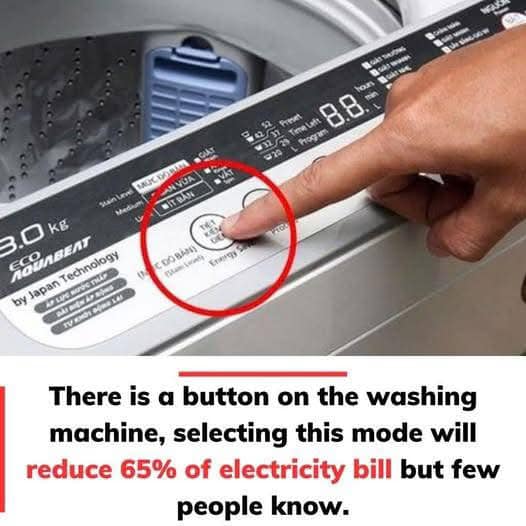Washing machines are an essential household appliance, making laundry day far more convenient. However, they are also one of the biggest contributors to your electricity bill. Running a washing machine regularly, especially with hot water settings, consumes a significant amount of energy, which can quickly add up over time. Fortunately, there’s a simple yet often overlooked trick that can save you up to 65% on your washing machine’s energy costs—a small adjustment to the temperature control button.

Many people might not even realize that their washing machines come equipped with this feature. The location of the temperature control button can vary depending on the model, but it’s generally easy to locate. Despite being a prominent feature, it’s often ignored, and most people simply press the start button without adjusting it. But this little button holds the key to significant energy savings.
Recently, a mother of two from the UK, Ms. Beth, shared her washing machine energy-saving tip on social media. Her advice quickly gained traction because of how straightforward and effective it is. According to Beth, most washing machines are preset to run at a water temperature of 40°C (104°F) by default. While this temperature is great for thoroughly cleaning heavily soiled clothes, it also consumes a lot more energy because the machine needs to heat the water to reach that temperature.
What many people don’t realize is that modern laundry detergents are formulated to work efficiently in cooler water. Beth suggests lowering the water temperature to just 20°C (68°F) for most laundry loads. This small adjustment can lead to staggering energy savings without compromising the cleanliness of your clothes.
Why Lowering the Temperature Saves Energy
Heating water accounts for a significant portion of the energy consumed during a wash cycle. The higher the temperature setting, the more energy your washing machine needs to heat the water. By switching from a 40°C cycle to a 20°C cycle, you’re cutting down on the energy needed for water heating by more than half. In fact, electronics manufacturers confirm that washing clothes at 20°C can reduce energy consumption by up to 62% per wash cycle.
This energy-saving tip works because today’s detergents are designed to perform well in cold water. They can effectively lift dirt, remove stains, and disinfect clothing even at lower temperatures. This means you don’t have to sacrifice cleaning quality when opting for cooler water settings.
The Environmental and Financial Impact
When you consider how many loads of laundry a typical household runs each week, the savings become even more significant. Not only does reducing the water temperature save money, but it also reduces your household’s overall energy consumption, which is better for the environment. With energy costs rising worldwide, every small adjustment adds up over time.
Switching to cold water washing also reduces the strain on your washing machine’s heating element, potentially extending the appliance’s lifespan. Less stress on the internal heating components means fewer breakdowns and costly repairs in the long run.
Experts Back the Cold Water Wash Tip
Cleaning and energy efficiency experts agree with Beth’s advice. Many recommend that most regular laundry loads can be safely washed at 20°C (68°F). Unless you’re dealing with extremely soiled items, greasy stains, or bedding that needs sterilization, there’s no real need to wash with hot water. Cold water is perfectly capable of handling day-to-day laundry tasks.
Moreover, modern washing machines are more efficient than ever, with energy-saving settings and better water circulation that improve cleaning performance even at lower temperatures. Detergents have also been reformulated to dissolve more effectively in cold water, ensuring that stains and odors are thoroughly eliminated.
How to Adjust Your Washing Machine Temperature
- Locate the Temperature Button: Look for a button or dial labeled “Temperature,” “Temp,” or with a thermometer symbol.
- Adjust the Setting: Switch the temperature setting from 40°C (104°F) to 20°C (68°F).
- Choose the Right Detergent: Use a high-quality detergent labeled for cold water washing to ensure the best results.
- Start the Cycle: Load your laundry, add detergent, and start the machine as usual.
If your washing machine has a dedicated Eco Mode or Cold Wash Cycle, make sure to take advantage of those settings. These programs are specifically designed to optimize energy efficiency while delivering clean results.
When to Use Hot Water Instead
While cold water is perfect for most everyday laundry, there are still a few scenarios where warm or hot water may be necessary:
- Heavily soiled items (e.g., greasy kitchen towels or muddy clothes).
- Sanitizing bedding or towels after illness.
- Removing tough stains like oil or blood (pre-treating these stains helps in cold water as well).
In these cases, occasional use of higher temperatures is acceptable. But for regular clothes and lightly soiled fabrics, cold water is more than sufficient.
Conclusion: A Simple Adjustment, Big Savings
Saving energy doesn’t always require drastic lifestyle changes—sometimes, it’s as simple as pressing a button. Adjusting your washing machine’s temperature setting from 40°C to 20°C is an easy, cost-effective way to reduce electricity bills by up to 65%.
This small habit not only keeps more money in your pocket but also reduces your environmental footprint and extends the lifespan of your washing machine. With detergents and washing machines now designed for cold water efficiency, there’s little reason to stick with high-temperature washes for everyday loads.
So next time you do laundry, don’t just press “Start” without a second thought. Take a moment to check your temperature setting—you might just be surprised by how much you’ll save over time.





